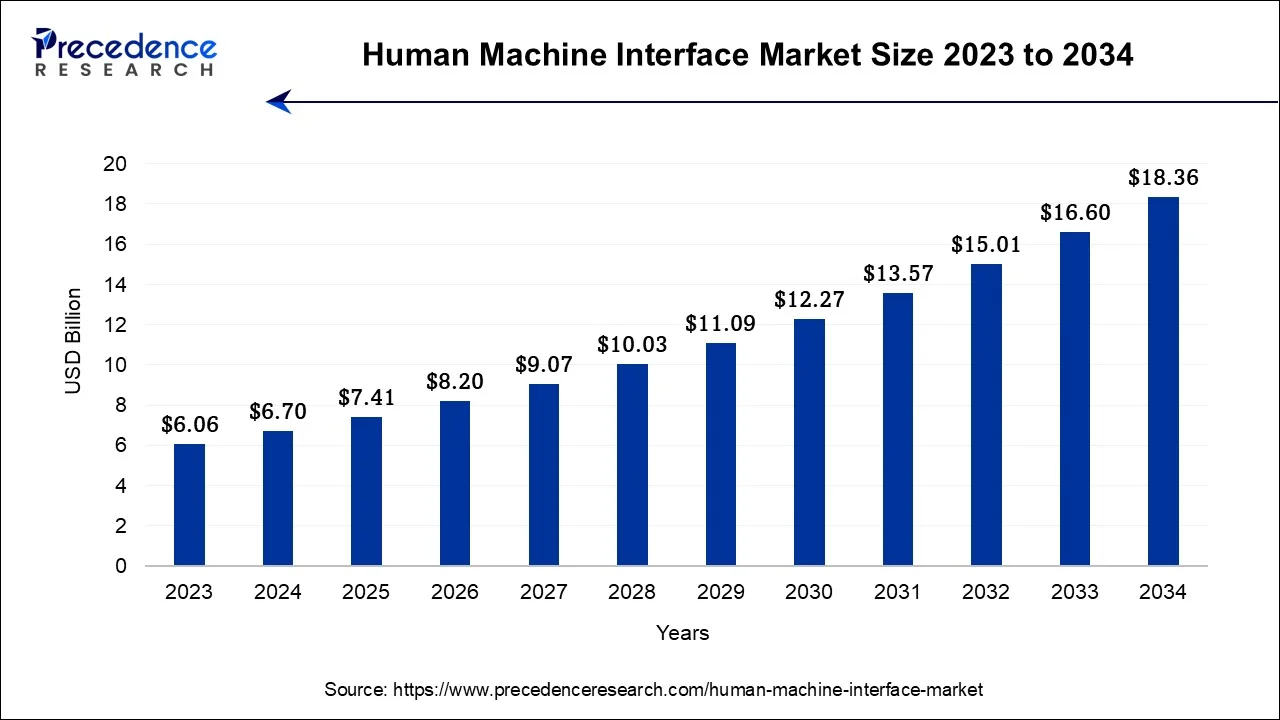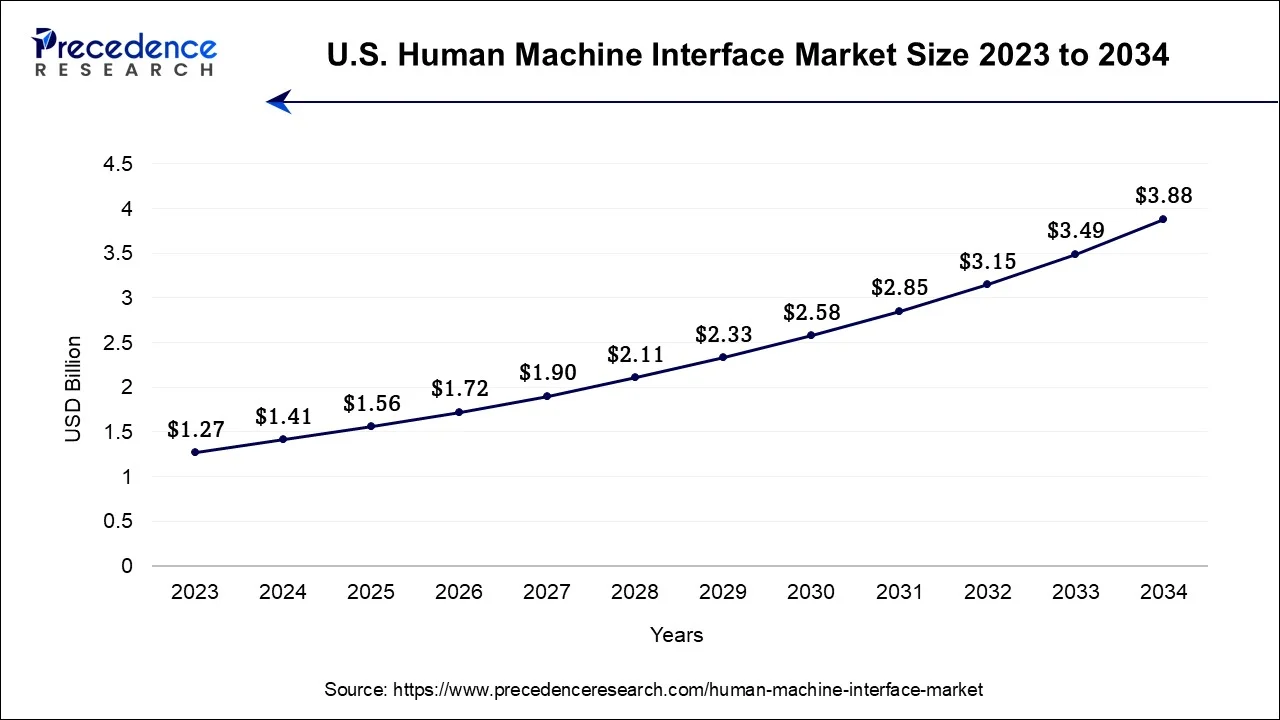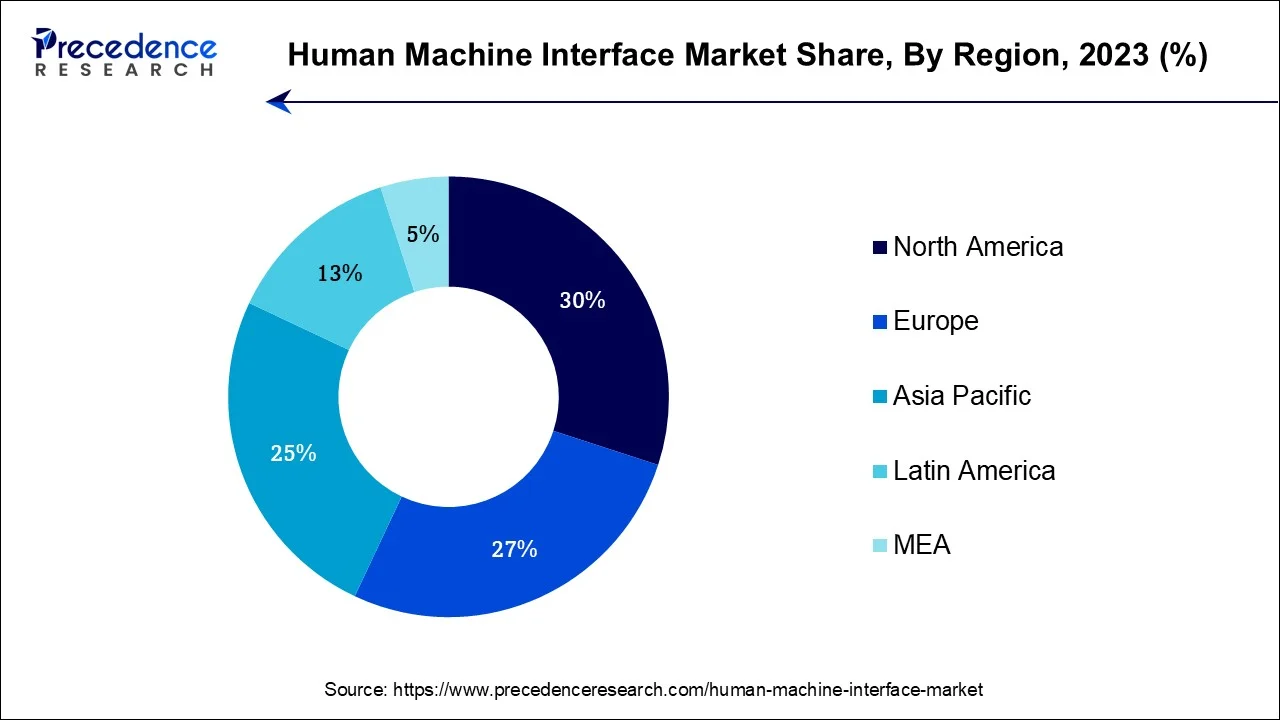March 2024
The global human machine interface market size accounted for USD 6.70 billion in 2024, grew to USD 7.41 billion in 2025 and is projected to surpass around USD 18.36 billion by 2034, representing a healthy CAGR of 10.60% between 2024 and 2034.
The global human machine interface market size is estimtated USD 6.70 billion in 2024 and is anticipated to reach around USD 18.36 billion by 2034, growing at a CAGR of 10.60% between 2024 and 2034.

The U.S. human machine interface market size accounted for USD 1.41 billion in 2024 and is estimated to reach around USD 3.88 billion by 2034, at a CAGR of 10.65% from 2024 to 2034.

North America accounted for the largest share of the human machine interface market in 2022; the region is anticipated to continue its growth during the forecast period. The North American human machine interface market is characterized by the rapid advancements in technological solutions, increasing investment in advanced technologies, the presence of prominent market players and increasing demand for high-resolution displays in multiple industries. Moreover, the increasing demand for autonomous vehicles and rising rate of industrial automation along with the adoption of robotics are few other factors to supplement the market’s expansion in North America.

Asia Pacific is expected to be the fastest-growing region throughout the forecast period. Asia Pacific is experiencing rapid industrialization; the element is expected to support the market’s expansion during the forecast period. In addition, rising emphasis on adopting advanced technologies, rapid adoption of Industry 4.0 and availability of skilled professionals are a few other factors to promote the expansion of the human machine interface market in Asia Pacific. Asia Pacific is witnessing an increasing rate of awareness regarding the benefit of human machine interface across various industries, and rapid growth of the manufacturing sector. The increasing adoption of industrial robots in India and China is positively influencing the market growth rate in the region.
The 2023 State of smart manufacturing study indicates that the growing interest of the Indian manufacturing sector to adopt digital technologies is expected to achieve digital transformation operational excellence. The focus on embracing Industry 4.0 to achieve global competitiveness, which matches with the Indian government’s vision of Atmanirbhar Bharat and Make in India. Thereby, such supportive factors aligned with developing countries in the region are expected to propel the market’s growth during the forecast period.
Human machine interface (HMI) is defined as the communication between humans and machines. The term human machine interface (HMI) can be applied to any screen that someone uses to interact with a device, but it is primarily used to describe such screens that are used in industrial settings. There are many other names for human machine interface (HMI), such as Man-machine interface, computer-human interface, human computer interface, Local operator interface (LOI), or operator interface terminal OIT).
The applications of human machine interface (HMI) are widely used in several different industries, such as Energy, Food and beverage, manufacturing, oil and gas, power, recycling, transportation, automotive, packaging, metal and mining, aerospace & defense, healthcare, electronics, entertainment, water and wastewater, pharmaceuticals, and others. human machine interface (HMI) enables users with the power to operate and control a system or machine.
The interface consists of software and hardware that permit users' inputs to be converted to machine-readable code, and then in turn, provide the required result to the user. It helps to reduce errors, improve user satisfaction, and boost overall productivity. The sophistication of the human-machine interface (HMI) varies as per the complexity of the machine, device, or system it is used for. In industries, human machine interface can be used for one function or for multiple purposes, such as monitoring plant operations and controlling equipment.
| Report Coverage | Details |
| Growth Rate from 2024 to 2034 | CAGR of 10.6% |
| Market Size in 2024 | USD 6.70 Billion |
| Market Size by 2034 | USD 18.36 Billion |
| Largest Market | North America |
| Base Year | 2023 |
| Forecast Period | 2024 to 2034 |
| Segments Covered | Offering, Configuration, End-User Industry, and Region |
| Regions Covered | North America, Europe, Asia-Pacific, Latin America, and Middle East & Africa |
The rising awareness regarding the benefits of human machine interface is expected to carve the way for growth of the human machine interface market during the forecast period. HMI enables safe messaging coupled with improved internal communications and alarm warnings is likely to fuel the growth of the market. The improvement in technology at a rapid pace along with the increasing internet adoption, resulting in the increasing use of human machine interface. Self-service kiosks, ATM machines, gas station pumps, self-checkout lines, industrial robots, and others use human machine interface to process user inputs and convert them to machine-readable code, and then perform the task without any assistance needed from an employee or attendant.
Self-ordering kiosk systems are becoming popular in the retail and restaurant business. Several retail outlets and restaurants are deploying self-service kiosks such as GRUBBRR, KFC, Maccas, Jubilant FoodWorks Ltd., and others to eliminate lines, free up employees’ time, deliver a better customer experience, and convenient options for customers. Self-ordering kiosks help restaurants reduce wait times and improve order accuracy.
The installation cost and maintenance cost of a human machine interface system can be relatively high, which acts as a major restraint for the growth of the human machine interface market. Small and medium-sized enterprises (SMEs) often face budget constraints that discourage them from embracing human machine interface systems. In addition, the high cost of advanced technologies including high-quality displays, voice recognition, gesture recognition, multi-touch screens, and others increases the expenditure of the installing company. Human machine interface systems may have different price points depending on the features, functionality, and brand. Some SMEs may be price-sensitive and opt for lower-cost or budget-friendly options with limited features.
The world is increasingly connected in the digitalization era, and more advanced networking technologies are being launched for industrial applications. Industrial automation devices are being launched to reduce labor and production costs and facilitate faster work processes. HMI plays an indispensable role in industrial automation to improvise industrial controls.
The software segment acquires the dominating share of the market. The rising implementation of human machine interface software for automation, especially in industries, is expected to fuel the demand for human machine interface during the forecast period. Human machine interface software improves the efficiency of manufacturing processes by offering flexibility and dependability for higher productivity. The human machine interface software helps in generating management reports, multiple control functions, alerts. Thereby, these factors are expected to propel the segment’s growth.
The embedded HMI segment held the largest share in 2023, with the growing technological advancements across the globe; the embedded HMI segment is projected to maintain its dominance in the human machine interface market. The embedded HMI configuration has the capability to manage complex features of human machine interface system. It also specializes in combining computer, software technologies and displays.
Embedded systems for human machine interface are widely being applied in multiple industries including food and beverages, medical, manufacturing and instrumentation. Great user experience, easy use and scalability offered by embedded systems promote the growth of the segment.
The automotive segment is anticipated to hold the dominating share of the market, the continuous advancement in technology in both, well-developed and developing countries is expected to grow the demand for human machine interface systems, especially in the automotive sector during the forecast period. The increasing popularity of feature-loaded vehicles, rising demand for autonomous vehicles, and adoption of smart automotive technologies such as self-driving cars, infotainment systems, advanced driver-assistance systems (ADAS), and others are expected to propel the growth of the segment.
The global human machine interface market is fragmented with multiple small-scale and large-scale players, following are a few of prominent key players in the market:
Segments Covered in the Report
By Offering
By Configuration
By End-User Industry
By Geography
For inquiries regarding discounts, bulk purchases, or customization requests, please contact us at sales@precedenceresearch.com
No cookie-cutter, only authentic analysis – take the 1st step to become a Precedence Research client
March 2024
August 2024
October 2024
December 2024